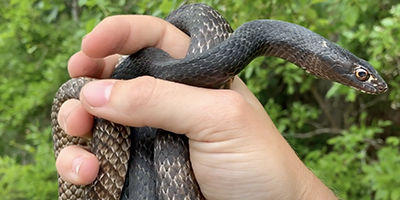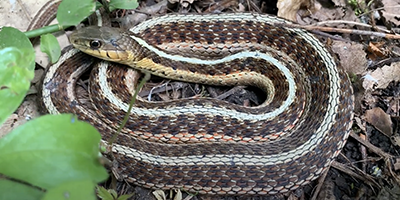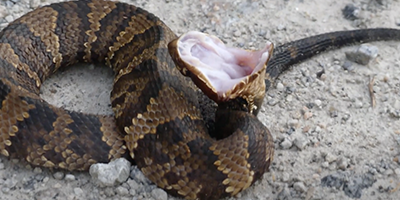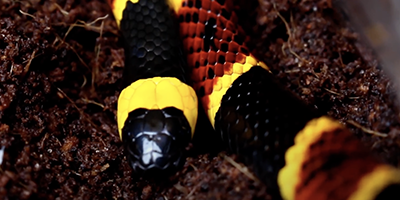
Welcome to montgomerysnakes.com! I am David, a snake enthusiast living in Montgomery, AL. Many people don't know that Montgomery is in fact full of snakes! You just need to know where to find them - they can often be shy and elusive. Some Alabama snake species are more common outside of the city limits, in different parts of Montgomery County AL, but many types of snakes are indeed common in the more urban parts of Montgomery. This guide is meant to help educate you about the beautiful snakes of Montgomery, and to help you identify the most common snakes of Montgomery, as well as the venomous snakes of Montgomery that you should learn to recognize and avoid. If you want more detail, click here for my complete list of ALL snake species in Montgomery. Remember the following:
- Most snakes of Montgomery are harmless and don't want to encounter you
- Venomous snakes exist but are uncommon in Montgomery, Alabama
- Snakes eat rats and mice and are a valuable part of the Alabama ecosystem
- Never kill a snake - if you leave a snake alone, it will leave you alone.
Common Snake Species in Montgomery
 Eastern coachwhip:
Eastern coachwhips have slender bodies, their head and neck are black, and the color of their body lightens as it reaches the tail. Some have tanned or cream-colored bodies, while some go through a completely black phase. The stomach of these snakes are of the same color as their backs, but two rows of black dots run down the length of their bodies in some cases. They have a length of 50-102 inches, making them one of North America's largest snakes. Coachwhips feed primarily on lizards, other snakes, birds, insects, and amphibians.
Eastern coachwhip:
Eastern coachwhips have slender bodies, their head and neck are black, and the color of their body lightens as it reaches the tail. Some have tanned or cream-colored bodies, while some go through a completely black phase. The stomach of these snakes are of the same color as their backs, but two rows of black dots run down the length of their bodies in some cases. They have a length of 50-102 inches, making them one of North America's largest snakes. Coachwhips feed primarily on lizards, other snakes, birds, insects, and amphibians.
 Eastern garter snake:
The eastern garter snake varies in color according to its geographic range. Three stripes that range from reddish, whitish, or yellowish in color runs down the length of their backs. Adult eastern garter snakes are usually between 18 to 36 inches long. They are found in wet and dry areas, including marshes, hillsides, drainage pits, abandoned places, and damp woodlands. The eastern garter snake feeds on any living thing that they can kill and swallow, ranging from small birds, eggs, insects, amphibians, and small rodents.
Eastern garter snake:
The eastern garter snake varies in color according to its geographic range. Three stripes that range from reddish, whitish, or yellowish in color runs down the length of their backs. Adult eastern garter snakes are usually between 18 to 36 inches long. They are found in wet and dry areas, including marshes, hillsides, drainage pits, abandoned places, and damp woodlands. The eastern garter snake feeds on any living thing that they can kill and swallow, ranging from small birds, eggs, insects, amphibians, and small rodents.
Venomous Snake Species in Montgomery
 Copperhead:
The head of the copperhead snake is wider than its neck, and the top of the head is copper in color. All species of copperheads have hourglass cross bands. The northern copperhead has a darker, reddish-brown color, while the southern copperhead has a color variation of light brown to tan or pink. They have elliptical pupils and pits between their eyes and nostrils. Southern copperheads are found in the lower coastal plain, while northern copperheads are found in the Alabama-Tennessee boundary, on the southern side of the Tennessee River, and Northeast Alabama, below the Tennessee River. They are found in forest areas, coastal plains, streams, and hedgerows. They feed on small mammals like mice. They also feed on salamanders, toads, birds, frogs, and insects.
Copperhead:
The head of the copperhead snake is wider than its neck, and the top of the head is copper in color. All species of copperheads have hourglass cross bands. The northern copperhead has a darker, reddish-brown color, while the southern copperhead has a color variation of light brown to tan or pink. They have elliptical pupils and pits between their eyes and nostrils. Southern copperheads are found in the lower coastal plain, while northern copperheads are found in the Alabama-Tennessee boundary, on the southern side of the Tennessee River, and Northeast Alabama, below the Tennessee River. They are found in forest areas, coastal plains, streams, and hedgerows. They feed on small mammals like mice. They also feed on salamanders, toads, birds, frogs, and insects.
 Cottonmouth:
This species of snake lives in water, and they are large. They have a thick broad head and are tan, black, olive, or brown. On the sides, lighter to darker cross band patterns are seen, and they have keeled scales. Wide dark stripes disguise their eyes, and they possess a pit between their eyes and nostrils. They are mostly found in aquatic habitats and coastal plain swamps. They live in wetlands, waterways, brackish water, swamps, streams, ponds, lakes, etc. The cottonmouth snake sunbathes on branches, stones, logs, and along water edges. The cottonmouth snake feeds on other snakes, salamanders, frogs, birds, mice, and other small mammals.
Cottonmouth:
This species of snake lives in water, and they are large. They have a thick broad head and are tan, black, olive, or brown. On the sides, lighter to darker cross band patterns are seen, and they have keeled scales. Wide dark stripes disguise their eyes, and they possess a pit between their eyes and nostrils. They are mostly found in aquatic habitats and coastal plain swamps. They live in wetlands, waterways, brackish water, swamps, streams, ponds, lakes, etc. The cottonmouth snake sunbathes on branches, stones, logs, and along water edges. The cottonmouth snake feeds on other snakes, salamanders, frogs, birds, mice, and other small mammals.
 Eastern coral snake :
The eastern coral snake is medium in size and has a short blunt head that is slightly wider than the neck. The snout and top of the snake's head are black, and the head's upper region has a wide yellow band. The eastern coral snake's body pattern is made up of complete, alternating, and transverse yellow, red and black rings (with yellow and red rings touching) that go around the length of the body. Adult snakes are about two feet long. They live in woody areas, sandy areas, and marshy areas. And most times, they are found underground or under piles of leaves. They feed on lizards, smaller snakes, frogs, and are cannibals too.
Eastern coral snake :
The eastern coral snake is medium in size and has a short blunt head that is slightly wider than the neck. The snout and top of the snake's head are black, and the head's upper region has a wide yellow band. The eastern coral snake's body pattern is made up of complete, alternating, and transverse yellow, red and black rings (with yellow and red rings touching) that go around the length of the body. Adult snakes are about two feet long. They live in woody areas, sandy areas, and marshy areas. And most times, they are found underground or under piles of leaves. They feed on lizards, smaller snakes, frogs, and are cannibals too.
If you're unsure, you can email me a photo of the snake at info@montgomerysnakes.com and I will email you back with the snake's species. If you found a snake skin, read my Found a Skin? page, and you can email me a photo of the skin, and I'll identify the snake for you. If you need professional Montgomery snake removal help, click my Get Help page, or see the below website sponsor I found, who provides that service.
Are Snake Excellent Climbers?
When in the wild, it will not be uncommon to find snakes dangling on trees, slithering on the branches to hunt for squirrels and nesting birds. Now that there has been an increasing presence of snakes in the suburban communities, you are probably wondering if they can also climb stairs. Owners of pet snakes will equally be curious about this since there may be some areas of their house that are restricted to the snakes.
Can Snake Climb Stairs?
Definitely! Snakes have the skills to traverse the stairs. The snake will do this by raising the upper part of its body to the stairs. The lower part of its body will then serve as a base. It will support them and give them enough strength to push their body to the next level of the stairs. With an average of 200-400 vertebrae, it is not surprising that this animal has impressive flexibility. The combination of having strong muscles and bones will not only serve as a protection to their internal organ, but it also helps them navigate on different terrains. The longer and bigger snakes such as the pythons and cobras can climb multiple steps in one go. They can easily extend their upper body forward that allows them to clear the stairs faster.
Can Snake Climb Walls?
Snakes can climb the walls of different human-made structures. They can squeeze their body on a particular section of the brick and use their powerful muscles to propel their bodies. However, if your walls have a smooth surface, this will pose a challenge to the snake. Your walls need to have grooves or ridges for them to climb the wall quickly.
Will the Snake Climb Stairs or Walls?
While stairs may not be an obstacle to snakes, they still need the motivation to climb them. For instance, there may be a colony of rats living in your attic. Some snakes can sense heat, pick up scent particles in the air, and feel vibrations that make them excellent hunters. They can easily identify the location of their prey. Do not think for a second that you are free from snakes if you live on the second floor of the apartment building. They are agile creatures that are capable of adapting to a range of environments.
Nonetheless, it would be best if you do not immediately freak out. You only need to make sure that there are no elements that will draw the snakes' attention. Resolve your rodent infestation issue, and they will be less interested in coming to your house.
If you live close to the natural habitat of snakes, make sure that your place will look less-attractive to the snake. Clear the clutter in your home and remove all the possible hiding ground of the reptile, such as the piles of rocks and woods. Mow your lawn regularly and trim the overgrown shrubs. If you happen to encounter a snake in your yard, do not approach them. Instead, call the wildlife removal expert and let them handle the job.
Remember, the term is not poisonous snakes of Montgomery, it's venomous snakes of Montgomery. Poison is generally something you eat, and venom is injected into you. That said, dangerous snakes are very rare in Montgomery. The few venomous snakes of Montgomery County are rarely seen. But they are commonly misidentified, so learn about all the snake species of Montgomery in order to correctly identify them. These snakes are usually also found in the surrounding towns of Montgomery, Millbrook, Prattville, Tuskegee, Troy, Selma, Alexander City, Auburn, Opelika, Sylacauga, Ozark, Alabaster, Valley, Eufaula, Pelham and the surrounding areas.
Read our article about:
Do Snakes Have Ears?
montgomerysnakes.com domain and hosting costs made possible by the generous support of this sponsor:
